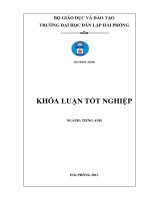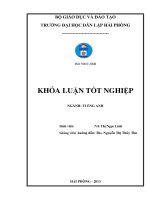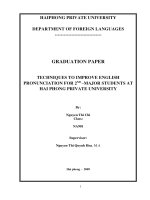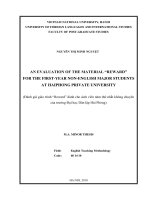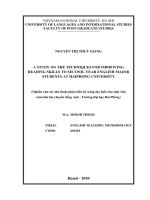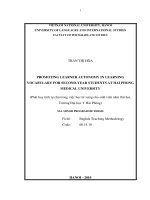Techniques to improve English pronunciation for second - major students at Hai Phong Private University
Bạn đang xem bản rút gọn của tài liệu. Xem và tải ngay bản đầy đủ của tài liệu tại đây (1.33 MB, 61 trang )
Haiphong private university
Department of foreign languages
-------------------------------
Graduation paper
Techniques to improve English
pronunciation for 2nd –major students at
Hai phong private university
By:
Nguyen Thi Chi
Class:
NA901
Supervisor:
Nguyen Thi Quynh Hoa, M.A
Hai phong – 2009
1
TABLE OF CONTENTS
Acknowledgements .....................................................................................................
Symbols and abbreviation ...........................................................................................
Table of contents ....................................................................................................... 1
INTRODUCTION ..................................................................................... 4
Rational of the study ................................................................................................... 4
Aims of the study ........................................................................................................ 4
Methods of the study ................................................................................................... 5
Design of the study ...................................................................................................... 5
Scope of the study ....................................................................................................... 5
DEVELOPMENT ..................................................................................... 6
CHAPTER I: THEORETICAL BACKGROUND ................................................ 6
1. PRONUNCIATION IN A LANGUAGE LEARNING ..................................... 6
1.1. The role of pronunciation in language learning ............................................. 6
1.2. Factors affecting pronunciation learning ........................................................ 6
1.2.1. The native language ......................................................................................... 6
1.2.2. The age factor ................................................................................................... 6
1.2.3. Amount exposure ............................................................................................. 7
1.2.4. Phonetic ability ................................................................................................. 7
1.2.5. Pesonality factors .............................................................................................. 7
1.2.6. Motivation and concern for good pronunciation ............................................. 7
1.2.7. Intellgibility ...................................................................................................... 8
2. ENGLISH CONSONANTS ................................................................................. 8
2.1. Articulators and places of articulation............................................................. 9
2.2. Definition and the basic consonants in English ............................................... 9
2.3. Classification of English consonants ................................................................ 9
2.3.1 According to place of articulation ...................................................................... 10
2
2.3.2According to manner of articulation ................................................................... 13
2.3.3 According to voicing .......................................................................................... 16
2.4. Consonant clusters ............................................................................................. 17
2.4.1. Initial clusters .................................................................................................... 18
2.4.2. Final clusters ................................................................................................... 18
3. ENGLISH STRESS ............................................................................................... 19
3.1. Characteristics of stressed word ....................................................................... 19
3.2. A summary of English word stress rules ......................................................... 20
4. VIETNAMESE CONSONANTS ......................................................................... 23
4.1. Definition and the basic consonants in Vietnamese ........................................ 23
4.2. Classification of Vietnamese consonants.......................................................... 23
4.2.1. According to place of articulation ..................................................................... 23
4.2.2. According to manner of articulation ................................................................. 24
4.2.3. According to voicing ......................................................................................... 26
4.3. Vietnamese initial and final consonants ........................................................... 26
5. VIETNAMESE TONE…...................................................................................... 28
5.1. Vietnamese pitch level ....................................................................................... 29
5.2. Vietnamese tone system ..................................................................................... 30
Chapter II. The common pronunciation problems faced
by Vietnamese ................................................................................................... 32
1. Consonant problems faced by Vietnamese ........................................................ 32
1.1. Difficulties in pronouncing English stop consonants .......................................... 32
1.2. Difficulties in pronouncing English fricatives consonants .................................. 33
1.3. Difficulties in pronouncing English consonant /r/ .............................................. 34
1.4. Difficulties in pronouncing English consonant clusters ...................................... 34
2. Stress problems faced by Vietnamese ................................................................. 35
2.1. In the word, all the syllables are stressed ............................................................ 35
2.2. Primary and/or secondary stress falls on the wrong syllable ............................... 36
Chapter III: Techniques to improve pronunciation.................. 37
3
1. Technique to raising awareness ........................................................................... 37
1.1. Model exercise ................................................................................................... 37
1.2. Minimal pair practice ........................................................................................... 39
1.3. Drilling practice.................................................................................................... 40
2. Technique to improve specific problems ............................................................ 40
2.1. Technique for English consonants ...................................................................... 40
2.1.1. Technique to pronounce English stop consonants ............................................ 40
2.1.2. Technique to pronounce English fricative consonants ..................................... 43
2.1.3. Technique to pronounce English consonant /r/ ................................................. 44
2.1.4. Technique to pronounce consonant clusters ..................................................... 46
2.2. Technique for English stress problems ................................................................ 51
3. Some games used to teach pronunciation ........................................................... 53
Conclusion .......................................................................................................... 54
Appendix ................................................................................................................ 55
1. Pronunciation journey ............................................................................................. 56
2. Cluster buster........................................................................................................... 57
3. Syllable soup ........................................................................................................... 58
4. Happy families ........................................................................................................ 59
REFERENCES .......................................................................................................... 60
Symbols and Abbreviation
C: Consonant
[x; y] : x shows the name of the text books listed in the part of Reference; the other
shows the page number in that books
Ex: [3; 20]
Vd: Voiced
Vs: Voiceless
Ex: Example
IPA: International Phonetic Alphabet
4
INTRODUCTION
1. Rationale
In Vietnam, English has found its ground in the educational system. The learners
have little opportunity to contact native input in the target language. Generally
speaking, learners are not surrounded by the English speaking world, and the
burden will fall on the teacher to provide model pronunciation of the English
language. Like learners elsewhere in the world, Vietnamese learners encounter
great difficulties in learning English pronunciation. During my English learning in
the university especially pronunciation learning in 2nd year, I myself find out that if
Vietnamese can understand and practice pronunciation clearly, judiciously, the
English pronunciation problems will be overcome.
For these reasons, I have decided to choose the subject “Techniques to
improve English pronunciation for 2nd - majors‟ student at Hai Phong private
university” to research.
2. Aim of the study
With the hope of getting more comprehensive and specific understanding of
English, finding out common pronunciation problems faced by Vietnamese and
giving some techniques to improve English pronunciation to Vietnamese, the aim
of the study include:
- To introduce the basic theories of English and Vietnamese consonants and stress.
- To find out what are common pronunciation problems faced by Vietnamese
- To give some techniques to improve 2nd year English majors‟ pronunciation
- To raise the learner‟s awareness of English pronunciation by giving specific
evidences, examples, figures, picture, chart, games …
5
3. The scope of the study
English pronunciation is a big theme; however, because of the limited time
and my knowledge, in this paper, I only focus on English consonant and stress
problems faced by Vietnamese and some techniques for teaching English to solve
these problems
4. Methods of the study
With the hope of finding out value and exact materials, methods of the study:
- Having discussion with my supervisor, friend etc
- Reading materials (text books, references…)
- Accessing internet
- Collecting typical examples
5. Design of the study
This paper provides a clear organization consisting 3 main parts that help an easy
exploration and practical benefits gained for reader as well:
Part I: The introduction including the rationale of the study, scope of the study,
aim of the study, methods of the study and design of the study.
Part II: The development consisting 3 chapters.
Chapter I: The theoretical background.
Chapter II: Common English consonant and stress problems faced by Vietnamese.
Chapter III: Some techniques to improve 2nd year English major‟ pronunciation.
Part III: Conclusion giving the summary of whole the study
DEVELOPMENT
6
CHAPTER I: THEORETICAL BACKGROUND
1. PRONUNCIATION IN LANGUAGE LEARNING
1.1. The role of pronunciation in language learning
A consideration of learner‟s pronunciation errors and how these can inhibit
successful communication is useful basis on which to assess why it is important to
deal with pronunciation in the classroom. When a learner says, for example, „soap‟
in a situation such as restaurant where they should have said „soup‟, the inaccurate
production of a phoneme can lead to misunderstanding. This can be very
frustrating for learner who may have a good command of grammar and lexis but
have difficulty in understanding and being understood by a native speaker
1.2. Factors affecting pronunciation learning
There are often obvious enough to make a person‟s origins identifiable by
untrained as well as trained people. One or two features are enough to suggest a
particular language „showing through‟ their spoken English
1.2.1. The native language
The nature of a foreign accent is determined to a large extent by a learner‟s native
language. The native language not only affects the ability to produce English
sounds but also the ability to hear English sound. The more differences there are
the more difficulties the learner will have in pronouncing English.
1.2.2. The age factor
We commonly assume that if someone pronounces a second language like a native,
they probably started learning it as a child. Conversely, if a person does not begin
to learn a second language untills adulthood, they will never have a native-like
7
accent even though other aspects of their language such as syntax or vocabulary
may be indistinguishable from those of native speakers.
1.2.3. Amount exposure
Another factor is the amount of exposure to English the learner receives. It refers
whether the learner is living in an English-speaking country or not. If the learner is
“surrounded” by English and this constant exposure should affect pronunciation
skills. If the learner is not living in an English-speaking environment, then there is
no such advantage
1.2.4. Phonetic ability
One study has indicated that good phonetic abilities benefit from pronunciation
drills, tasks in which particular sounds are heard and the learner has to imitate
again and again. We can only operate on the assumption that our learners have the
„basic equipment‟ and provide a variety of tasks so that something will suit the
needs and abilities of each learner
1.2.5. Pesonality factors
Learners who are out-going, confident, and willing to take risks probably have
more opportunities to practise their pronunciation of the second language simply
they are more often involved in interactions with native speakers. Conversely, who
are introverted, inhibited, and unwilling to take risks lack opportunities for practice
ESL teacher should strive to create a non-threatening atmosphere in their
classrooms so that student participation is encouraged
1.2.6. Motivation and concern for good pronunciation
Some learners seem to be more concerned about their pronunciation than others.
This concern often requests for correction- “Please correct my pronunciation
whenever I make a mistake” and frequent pauses during speech used to solicit
8
comments on the accurate of pronunciation. It may even be reflected in a
reluctance to speak- the “I don‟t want to say it if I can‟t say if perfectly” mentality.
The desire to pronounce well is a kind of „achievement motivation‟. Conversely, if
you don‟t care about a particular task or don‟t see the value of it, you won‟t be
motivation to do well.
1.2.7. Intellgibility
“Intelligibility is being understood by a listener at a given time in a given
situation”. So, it‟s the same as „understandability‟. Although the foreign speaker
doesn‟t make precisely the same sound or use the exact feature of linkage or stress,
it is possible for the listener to match the sound heard with the sound (or feature) a
native speaker would use without too much difficulty. So, what matters is „counts
of sameness‟. For example, a child of three or four may have problems
pronouncing the /r/ sound, as in „run‟, and may use a /w/-like sound as in „win‟.
The child may say; „I see a wabbit ‟. The parents will understand that the child has
seen a furry animal with long ears, because they know that /w/ counts as /r/ for
their child.
2. ENGLISH CONSONANTS
To pronounce English accurately, it is essential to have an understanding of how
the speech sounds of English are produced. It will enable you to take the necessary
steps for correction of the students‟ pronunciation problems. Different speech
sounds result when the airstream is altered in some way by the positioning of
various parts of the mouth. This alteration is basic which help classify English
consonants
9
2.1. Articulators and places of articulation
Figure .1: Articulators and places of articulation
Articulators : involved the movable parts of the
mouth
1. Tip of tongue
2. Blade of tongue
3. Back of tongue
Places of Articulation : involve the unmovable parts
of the mouth
4. Teeth
7. Soft palate ( velum )
5.Tooth ( alveolar) ridge
8. Glottis
6. Hard palate
9. Uvula
2.2 Definition and the basic consonants in English
Definition:
In articulator phonetic, a consonant is speech of sound that is articulated
with complete of partial closure of the upper vocal tract; the upper vocal tract is
defined as that part of vocal tract lying above the larynx.
[4; 23]
Consonants are formed by interrupting, restricting or diverting the airflow in a
variety of ways.
[9; 147]
The basic consonants in English conclude: /b/, /p/, /d/, /t/, /g/, /k/, /v/, /f/, /ʤ/, /ʃ/,
/ʒ/,/ ʧ/, /s/, /z/, /h/, /ð/, /θ/, /m/, /n/, /l/, /r/, /w/, /y/, /hw/, /ŋ/
10
2.3. Classification of English consonants
There are 3 ways of describing the consonant sounds:
1. The place of articulation
2. The manner of articulation
3. The voicing
2.3.1 According to place of articulation
In the English, there are six places in the mouth where the airstream is obstructed
in the information of consonants.
Sounds made with the lips
Both lip - bilabial: /p/, /b/, /m/
Pronounce the words „pat‟, „bat‟, and „mat‟, paying attention to the way the first
consonants of each word is made. The first sound in each these words is made with
the two lips coming together and touching momentarily. The obstruction of the air
stream thus occurs at the lips.
The sound /p/, /b/ and /m/ are referred to as bilabial sounds because the two (bi-)
lips(labial) are involved in their production
Figure 2: The position of the lips
Figure 3. The position of the teeth
in the production of /p/, /b/, /m/
and lips in the production of /f/, /v/
11
Lower lip and upper teeth - labialdental: /f/, /v/
Produce the words „fat‟ and „vat‟. The initial sounds of these words are made with
the top teeth touching the bottom lip. Therefore, the obstruction of airstream occurs
because the bottom lip and the top teeth come together.
The sound /f/, /v/ are referred to as labialdental sounds because the lips (labial) and
the teeth(dental) are involved in their production.
Sounds made with the tip of the tongue
Tip of the tongue and the teeth - interdental: /ð/ and /θ/
Pronounce the words „think‟ and „this‟. With first consonant sounds of these words
the obstruction of the air stream occurs because the tip of the tongue is between the
teeth or just behind teeth. The “th” sound in „think‟ and „this‟ is represented by
symbol /θ/ and /ð/
Tip of the tongue and the tooth ridge – alveolar :/t/, /d/, /n/, /l/, /s/, /z/, /r/
Pronounce the words „tip‟, „dip‟, „nip‟, „lip‟, „sip‟, „zip‟ and „rip‟. When you
pronounce the initial consonants of these words, you should feel the tip of your
tongue touching the roof of your mouth just behind your upper teeth with /t/, /d/,
/n/, /l/ and approaching the tooth ridge with /s/, /z/, /r/. These sounds are referred to
as alveolar because the tongue either touches or approaches the alveolar ridge in
their production
Figure 4.The position of the tongue
Figure 5.The position of the tongue
the production of /θ/ and /ð/
in the production of /t/, /d/, /n/, /l/
12
Sound made with the blade of the tongue
Blade of the tongue and the hard palate - alveolar-palate: /ʒ/, /ʃ/,
/ʧ/,/ʤ/
When you pronounce the final sound of „wish‟, „beige‟ and initial sound of
„chain‟, „june‟, the blade of the tongue approaching the hard palate just behind the
tooth ridge. Notice that the lips are rounded when you pronounce /ʒ/, /ʃ/
Figure 6: The position of the tongue
Figure 7: The position of the tongue in
in the production of /ʒ/,/ʃ/,/ʧ/ and/ʤ/
the production of /k/, /g/, /ŋ/
Sounds made with the back of the tongue
Back of the tongue and soft palate - velar /k/, /g/, /ŋ/
When you pronounce initial sounds of „coat‟ and „goat‟ and final sound of „sing‟,
the back part of your tongue touches the back part of your mouth momentarily,
causing the obstruction of the airstream.
The sound /k/, /g/, /ŋ/ are referred to as velar sounds because they are made with
the back of the tongue rising to touch the soft palate or velum
13
The places of articulation for consonants can be summarized as following:
Place of articulation
Bilabilal
Labiodental
p,b
Interdental Alveolar
f,v
θ,ð
Alveolarpalatal Velar
t,d
l,n
m
ʃ,ʒ
ʧ,ʤ
k,g
ŋ
s,z,r
2.3.2 According to manner of articulation
Manner of articulation refers to the interaction between the various articulators and
the airstream.
There are 7 groups of consonants classified according to manner of articulation:
Complete obstruction of the airstream – Stops
Are the sounds made by the air that passes from the lung into the mouth can be
completely stopped because the lips or the tongue actually touch some parts of the
upper mouth, and then escaped strongly causing a closure:
The stop consonants of English:
Lip (bilabial)
/p/ and /b/
Tooth ridge (Alveolar)
/t/ and /d/
Soft palate (velar)
/k/ and /g/
Figure 8:Complete blockage of the
Figure 9: Partial blockage of the
airstream as in the stops /t/ and /d/
airstream as in the fricative /s/ and /z/
14
Partial obstruction of the air stream – Fricatives
Are the sounds produced by forcing the airstream through a narrow opening
between the lips and the teeth or the tongue and the teeth
The fricative consonants of English:
Lower lip/upper teeth (labiodental)
/f/ and /v/
Teeth (interdental)
/ð/ and /θ/
Tooth ridge (alveolar)
/s/ and /z/
/ʃ/and /ʒ/
Hard palate (alveolar palate)
Complex consonant sound - Affricative:
Each of combination of a stop followed immediately by a fricative and they are
inferred to as affricative. The initial sound of „chain‟ begins as the stop consonant
/t/, and is released as the fricative /ʒ/.
The complete consonants of English
Hard palate
/ʧ/ and /ʤ/
Sounds made with the air escaping through the nose – Nasal
Nasal sound is made with air passing through the nose. Air is block in the mouth in
the same way as it is for stop consonants. However, the soft palate is lowed
allowing air to escape through the nose
The nasal consonants of English: Lips (bilabial)
/m/
Tooth ridge (alveolar)
/n/
Soft palate (velar)
/ŋ/
Figure 10.The position of the velum
in the production of /k/ and /g/
Figure 11:The position of the velum
the production of nasal consonant /ŋ/
15
Lateral
Lateral sound is made with the tip of the tongue touching the tooth ridge and the
air passing through the mouth over the sides of the tongue: /l/
Retroflex
Retroflex sound is made with the tip of the tongue slightly curled back in the
mouth. Because the tongue is curled back during the pronunciation of the /r/ sound,
it is referred to as retroflex consonant
Semivowel
Semivowel sounds are made with a relatively wide opening of the mouth. In the
pronunciation of /w/ the lip are rounded and, at the same time, the back of the
tongue approaches the soft palate. It is difficult to feel this but, in fact, this
narrowing occurs as well
In the pronunciation /y/, the blade of the tongue approaches the hard palate .You
should be able to feel the tongue coming close to the hard palate
Figure 12: The position of the tongue
Figure 13: The position of the tongue
in the production of the lateral /l/
in the production of the retroflex /r/
16
The manner of articulation can be summarized as following:
Manner of articulation
Stop
Fricative Affricative Nasal
p, b, t,
f, v, θ, ð
d, k, g
Lateral
Retroflex
Semi-vowel
l
r
w, y
s, z, ʃ, ʒ
m, n, ŋ
ʧ, ʤ
2.3.3. According to voicing
Sounds that are made with the vocal cord are voice and sounds made with no
vibration are voiceless
All of stops, fricatives and affricatives so far come in voiced/voiceless pairs. The
nasal, lateral, retroflex and semi-vowel are all voiced
Voiceless: p, t, k, f, s, θ, ʃ, ʧ
Voiced: b, d, g, v, ð, z, ʒ, ʤ, m, ŋ, l, r, w, y
Classification of the consonants of English in terms of place of articulation,
manner of
articulation, and voicing:
Bilabial
Labia-
Dental
Alveolar Alveolar Velar
dental
Stops
-palatal
Vd
b
d
g
Vs
p
t
k
Fricatives
Vd
ʤ
Vs
Affricatives
ʧ
v
Vs
Nasals
Vd
f
ð
θ
m
z
ʒ
s
ʃ
ŋ
n
Lateral
l
Retroflex
r
Semi-vowel
w
y
17
2.4. Consonant cluster
Consonant cluster is when two and more consonant together. It is divided into
initial and final consonant cluster
2.4.1. Initial cluster
Initial cluster is the cluster at the initial position of a syllable
Initial two-consonant cluster of English
Stop
lips
Fricative
Nasal
Tooth velum Lips and Between Tooth
Hard
ridge
palate
teeth
pl
tr
kl
ty
kr
fr
py
tw
ky
fy
bl
dr
kw
br
dy
gl
by
dw
ridge
fl
pr
teeth
sl
ridge
gr,gw
θr
sm
Tooth
sk
sy
lip
h
ʃr
sw sn
θw
sp
my
ny
hy
sf
hw
st
Initial three-consonant cluster of English
These initial three-consonant clusters are usually produced with a pre-initial, an
post-initial and a /p/, /t/, /k/ at the medium of pre-initial and post-initial
Cluster
spl
Example splice
spr
spy
str
sty
skr
sky
skw
spring
spew
string
stew
screw
skew
squirt
2.4.2. Final cluster
A final consonant cluster is the cluster at the final position of a syllable. The
consonants that occur in final clusters are not necessarily the same as which occur
in initial clusters
18
Final two-consonant cluster of English
nasal
lips
Tooth
liquid
velum
l
fricative
stop
r
ridge
nt
nʧ
M(p)f nd
ŋk
nʤ
Mp
lp
lv
lb
lθ
ns
ld
ls
nθ
lk
lʃ
lʧ
rp
rŋ
rʤ
sp
pt
ts
lʤ
rb
rf
rm
st
pθ
kt
lm
rt
rv
rn
sk
ps
ks
ln
rd
rʃ
rl
ft
tθ
dz
rk
rʧ
lf
fθ
Final three-consonant cluster of English:
stop
nasal
liquid
cluster
example
cluster
example
cluster
example
kst
text
mpt
exempt
lts
waltz
ksθ
sixth
mps
glimpse
rps
corpse
nts
prince
ts
quartz
nst
againt
rst
first
ld
world
rlz
Charles
r(p)θ
warmth
Final four- consonant cluster of English
The grammatical ending creates many more final consonant clusters than the list
above such as: The past tense ending /t/ and the plural ending /s/. Most of fourconsonant cluster can be analyzed as consisting of consonant preceded by pre-final
and followed by post-final 1 and post-final 2
19
Example: In the below table:
Pre-final
Final
Post-final 1
Post-final 2
Twelfths /twelfθs/ l
f
θ
s
Prompts
p
t
s
m
/prompts/
3. STRESS
Correct word stress patterns are essential for learner‟s production and perception of
English. If a non-native speaker produces a word with the wrong stress pattern, an
English listener may have great difficulty in understanding the word, even if most
of individual sounds have been well pronounced.
3.1. Characteristics of stressed word
What are the characteristics of stressed syllables that enable us to identify them?
All stressed syllables have one characteristic in common, and that is prominence.
Stressed syllables are recognized as stressed because they are more than unstressed
syllable.
What make a syllable prominent? At least four different factors are important.
The loud: Stressed syllable are louder than unstressed. If one syllable is made
louder than the others, it will be heard as stressed
The length: If one syllable is made longer than the others, there is quite a strong
tendency for than that syllable to be heard as stressed
The pitch: If all syllables are said with low pitch except for one said with high
pitch, then the high-pitched syllable will be heard as stressed and the others as
unstressed
The quality: A syllable will tend be prominent if it contains a vowel that is
different in quality from neighboring vowels
20
2. A summary of English word stress rules
Rule 1: “Front weight” in nouns and adjectives. There seems to be a very strong
tendency in English for what is called core vocabulary to have stress on
the first syllable. The mean that many common nouns and adjective will
have stress on the first syllable.
Examples:
water
people
brother
table
finger
woman
sister
ugly
father
butter
pretty
apple
mother
Rule 2: Two-and three-syllable words which have prefix. In words with prefixes
such
as „be-,in-, dis-, ex-, un-, etc., the stress is almost always on the
second or third syllable ,i.e prefix are not stressed in English words. Note
that the majority of these words are verbs
Examples:
repeat
begin
because
distrust
increase
exhaust
infer
inspect
conclude
confer
invite
understand
Rule 3: Words with suffixes‟ we examine English words with suffixes, a similar
tendency is revealed: suffixes are never stressed.
Examples:
-ly
quietly
-al
original
-ive
administrative
-ent/ant
equivalent
-ic
automatic
Another general tendency is for the stressed syllable to be some where in
the middle of the words, rather than on the first or last syllable in words
or four, five, or six syllable
21
Rule 3.1 Certain suffixes determine on which of the other syllable the stress will
fall. There are very many suffixes which cause the syllable before the
suffixes to be stressed. These are:
-ive
-iate
(deviate) ['di:vieit]
-ient
-iant
(impressive) [im'presiv]
(incipient) [in'sipiənt]
-iary
(pecuniary) [pi'kju:niəri]
-iant) (deviant) ['di:viənt]
-iable (negotiable) [ni'gou∫ieit]
-ial
(substantial) [səb'stæn∫əl]
-ish
(diminish) [di'mini∫]
-ion
(invention) [in'ven∫n]
-ify
(identify) [ai'dentifai]
-ic
(geographic) [dʒiə'græfikəl]
-ium
(premium) ['pri:miəm]
-ian
(median) ['mi:djən]
-ior
(superior) [su:'piəriə]
-io
(radio) ['reidiou]
-ious (infectious) infectious
-ical
(economical) [,i:kə'nɔ mikəl] -iar
(familiar) [fə'miljə]
-ity
(opportunity) [,ɔ pə'tju:niti]
(impossible) [im'pɔ səbl]
-ible
It doesn‟t if the stress was on a different syllable in the form of the word
without the suffix (sometime called the „base‟ word); the stress will move
from wherever it was to the syllable before the suffix when any of these
suffixes are added
Rule 3.2.The suffix „-able‟ usually does not change the stress pattern of a word to
which it is added. So in „commendable‟ in remain on the second syllable
Example:
adapt [ə'dæpt]
adaptable [ə'dæptəbl]
rely [ri'lai]
reliable [ri'laiəbl]
knowledge ['nɔ lidʒ]
knowledgeable
detest [di'test]
['nɔ lidʒəbl]
Exceptions:
demonstrate ['demənstreit]
demonstrable ['demənstrəbl]
admire [əd'maiə]
admirable ['ædmərəbl]
prefer [pri'fə:(r)]
preferable ['prefrəbl]
22
Rule 3.3.The following suffixes cause the stress to be placed on the a fourth
syllable from the end of the word(this applies, of course, only to words of
four or more syllable)
-ary (vocabulary) [və'kæbjuləri]
-ator (investigator) [in'vestigeitə]
-mory (alimony) ['æliməni]
-acy
-ory
Rule 4.
(intimacy) ['intiməsi]
(category) ['kætigəri]
Compound words: There are also some rules for determining stress in
compound words. These are words which are formed by combining two
nouns, a noun and a adjective, a verb and a preposition, etc. It is very
common for compound words which are nouns to have stress on the first
element. So, the tendency is Rule 1 also applies to compound nouns
Example:
A newspaper
A postman
A put-on
A crossword
A teapot
A chairman
A grandfather
A hotdog
Some compound words are formed from an adjective plus a noun. When
the same two words are used separately in a sentence, each word will
have equal or independent stress. For example, compare:
What a beautiful blackbird!
Look at that big black bird!
There is a set words which can be used as either a verb or a noun in
English (there are a few cases of noun or adjective):
Increase
export
import
overflow
insult
content
decrease
In all these words, the noun has the stress on the first syllable, and the
verb has the stress on the last syllable. This seem to fit with Rule 1 and 2:
The noun will have front weight and the verbs, with a prefix as the first
syllable, will have stress on the second
23
4. VIETNAMESE CONSONANTS
4.1. Definition and the basic consonants in Vietnamese
Definition
Consonants in Vietnamese is a component of syllabication, and is the mainly initial
sound in Vietnamese syllable
Vietnamese consonants can occur at the initial or final position of Vietnamese
syllable but common at the initial position
The basic consonants in Vietnamese
The Vietnamese phonetic system contains 23 initial consonant : /b/, /f/ (ph), /v/,
/m/, /t/, /d/ (đ), /tʰ/ (th), /s/ (x), /z/ (d), /n/, /l/, /t / (tr), /ş/ (s), /ž/ (gi,r), /c/ (ch), /ɲ/
(nh), /k/ (c, k, q), /γ/ (g), /χ/ (kh), / N / (ng), /h/, /p/, /r/
The possible Vietnamese consonants are represented in the following chart based
on the place and manner of their production (articulation).
In Vietnamese there are six final consonants: /p/, /t/, /k/ (c/ch), /m/, /n/, /N/ (ng/nh)
and two final semivowels: /i/ (i/y), /u/ (o/u).
4.2. Classification of Vietnamese consonants
4.2.1. According to place of articulation
There are 6 groups of Vietnamese consonants classified according to place of
articulation, those are:
Labial: are the sound made with two lips or with the lower lip touching the
upper teeth:/p, b, m, f, v /
Ex: The underlined consonant in the word
/p/ “úp” (cover up)
/b/ “ba” (three)
/f/ “phố” ( stresst)
/v/ “vở” (book)
24
/m/ “một” (one)
Apical- dentals: are the sound made with the tip of the tongue touching the
upper or lower teeth:/th, t, d, n, s, z, l/
Ex: The underlined consonant in the word:
/th/ “thu” (autumn)
/t/ “tai” (ear)
/d/ “đen” (black)
/n/ “não” (brain)
/s/ “xa” (far)
/z/ “giặt” (washing)
/z/ “da” (skin)
/l/ “lá” (leaf)
Apical-palatal: are the sound made with the blade of the tongue /t, ş, r/
Ex: The underlined consonant in the word:
/t/ “trà” (tea)
/ş/ “sách” (book)
/ž/ “rác” (rubbish)
Dorsal sound: are the sound made with the blade of the tongue: /c, nh/
/c/ “chanh” (lemon)
/ɲ/ “nhanh” (fast)
Radical sound: are the sounds made with the back of the tongue: /k, ŋ, γ, x /
Ex: The underlined consonant in the word:
/k/ “cá” (fish)
/k/ (qủa)
/ŋ/ “Nga” (Russia)
/ŋ/ “nghe” (hear)
/x/ “khe” (slit)
/γ/ “ga” (station)
(fruit)
/k/ “kem”
/γ/ “ghế”
(ice-cream)
(chair)
Glottal: is the sound made with the epiglottises: /h/
Ex: The underlined consonant in the word : /h/ “hai” (two)
4.2.2. According to manner of articulation
There are 5 main groups of Vietnamese consonants classified according to manner
of articulation:
25
